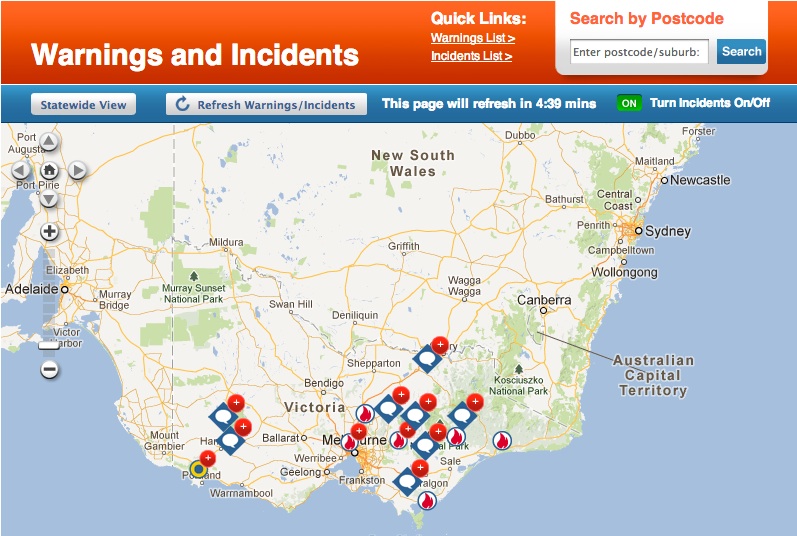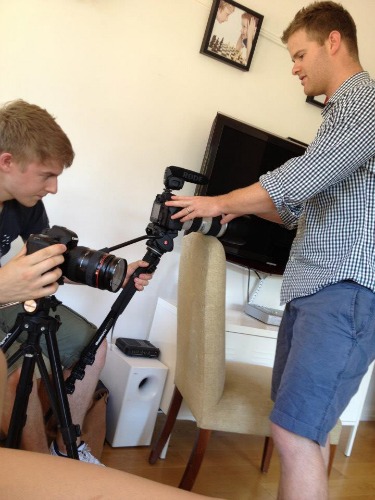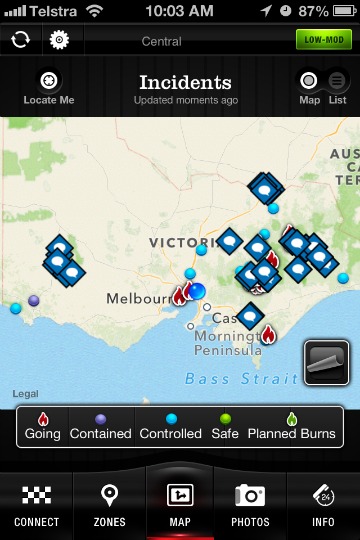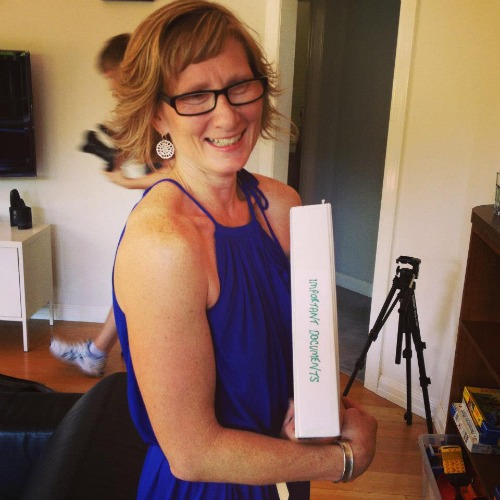This post is sponsored by Nuffnang.
We recently visited some of my husband’s family who live out St Andrews way on the outskirts of Melbourne. This area was one of the hardest hit by the Black Saturday fires in 2009. They lost their house and everything in it, but felt lucky as their neighbour lost his life. We were all fascinated by their story of survival and blown away by the lump of metal they showed us which was all that was left of their car.
Bush fires are a real and common danger in Australia, but I have to admit to have not really thought much about what I would do if a fire was to threaten our home. I have succumbed to one of the key myths surrounding the Australian fire season, in that I think I won’t be affected where I live in the ‘burbs!
According to the CFA, these are some of the most commonly held myths about bush fires:
MYTH: If you live in a residential suburban area you’re safe.
FACT: Even on the urban fringe you are at risk of fire. In strong winds, embers can travel up to 35 kilometres in front of a fire, starting new fires. People who travel or holiday in high risk bushfire areas are also at risk of bushfire. Even people considering a day trip should be prepared.
MYTH: Code Red days happen all the time.
FACT: Code Red days are rare. There have been two Code Red Days in the last three years. Code Red is the highest Fire Danger Rating. Houses in Victoria are not designed or constructed to withstand fires on these days.
MYTH: It will be safe to leave even if I can see fire.
FACT: Roads might be blocked, thick smoke will make it difficult to see, the fire could travel faster than you drive and fires can leap highways. Every minute you wait, it gets closer.
MYTH: CFA will be able to send a fire truck or come to my rescue.
FACT: If the CFA is fighting fires, they can’t be knocking on doors. It’s your responsibility to make the best possible decision for your family based on the current Fire Danger Ratings and official warnings for your area. It’s up to you to know when to leave.
MYTH: Winter has been very wet so there’s less chance of a fire in summer.
FACT: Rainfall fuels the growth of vegetation, especially grass, creating more fuel for fire. In years of wet weather, Victoria often sees an increase in the number of large grassfires. It only takes two weeks of hot, dry and windy weather to create dangerous fire conditions.
MYTH: All barbecues are banned on a Total Fire Ban day.
FACT: Solid and liquid-fuel barbecues and ovens are banned on Total Fire Ban days. You can still use gas or electrical barbecues that are fixed appliances – built into permanent structures of brick, stone or concrete – provided you adhere to the guidelines for use located at http://www.cfa.vic.gov.au/warnings-restrictions/can/. Portable gas or electric barbecues are also allowed if they are commercially manufactured exclusively for meal preparation and you ensure they are in a stable position when alight.
While the chances of us being caught up in a bush fire in our home maybe much less than my husbands’ family, there is still a level of threat and of course we travel. We travel regularly through parts of Victoria, that during this time of year have significant fire danger. So I was happy to take on the Fire Ready Challenge when asked by the CFA.
Before the challenge all I knew was:
- They would chat with me at the start about what I knew about being fire ready and how I felt about doing the challenge.
- I would be set a 10 minute challenge which would be focused on being prepared for a bush fire.
- I would then discuss how I think I coped with the challenge.
The film crew arrived around 1pm Saturday afternoon. From Friday night to 1pm Saturday afternoon, we had attended the kinder pizza night, had two futsal games, a cricket game, two kids at Milo Cricket, a touch rugby game, a run for me and fruit and veg shopping from Mr I. So I felt that I was realistically ready to take the challenge – I hadn’t had two seconds to think about it!
Once they said my 10 minutes had started, I scanned the list they gave me and tried to work out what would be the most important things from the list I should focus on first. I am not sure if it was just because I had the camera following me, or because I was thinking back to my husbands’s family’s recent experience, but I did feel a real sense of urgency.
The 10 minutes absolutely flew by and I think if you were to give marks out of 10, I may have been lucky to have achieved a five. This little video above gives you the highlights {if you are reading this post in email, please click through to the blog to see the video}.
This is what I thought I did well
- I could easily obtain the families important documents.
- I could take care of most of my business things, by simply taking the hard drive back up.
- Blankets were easily accessible.
- I knew where my neighbours were at.
Things I struggled with
- I should have taken the suitcases to the main room first off and packed them instantly to save time.
- I didn’t have shoes for the kids or better shoes for myself.
- I didn’t pack any water.
- I wish I had the CFA Fire Ready app on my phone, so I could have taken that around the house with me as I packed what I needed. I should have been checking more frequently on the current advice for my area on the CFA website and also checked for a safe route away from the home.
- I also should have turned the radio on to our local ABC radio station. CFA recommends not relying on only one source of information. You can see other sources of information listed here.
- I didn’t take any toiletries and wouldn’t have had enough food for the three days they had stated I should pack for.
This second video above is a snapshot of how I felt immediately after the challenge – you can even tell I am a little puffed from all the rushing around! {Again if you are reading this post in email, please click through to the blog to see the video}.
What mattered
Even though it was only a challenge, I found myself really just focusing on getting the absolute basics, so the family would be safe. The challenge said to find three precious items that you wanted to take with you. Once I had my hard drive which contained both work files and family photos, nothing else seemed to matter.
And now I understand why when my husband’s relative said that on Black Saturday, as they were about to leave their burning house, she saw her handbag on the bench and was about to get it and thought “I don’t need it” and left without it.
What I learnt
- I should have the fire ready app on my phone and Galaxy Note II.
- Having a husband who created an important documents about folder 15 years ago made things so much easier!
- It shouldn’t just be me who knows about being fire ready. For the purposes of this challenge, it was just me, but afterwards my eldest son said “We would have helped mum, we wouldn’t have just sat there.” And he is right. Teaching the kids how to access the fire ready app or website would be incredibly helpful and making sure they know what we would need to take with us.
- Like with other areas of family life, being fire ready isn’t necessarily hard, but it takes prior planning, so when the unexpected happens we are in the best position possible to cope. You can download a free Fire Ready Kit, which has been designed to help you understand your risk, prepare your property and develop a Bushfire Survival Plan on the CFA website.
- When I am going to be driving in areas of high fire danger, I should check the app before I go and the CFA website for Fire Danger Ratings and Total Fire Ban declarations. Then while driving make sure I source updates from two available sources – tuning into the local ABC radio and have someone check updates on the app in the car while I am driving.
For more information on being Fire Ready you can connect with the CFA via:
- CFA website – www.cfa.vic.gov.au
- CFA Facebook Page – www.facebook.com/cfavic
- CFA Twitter – @CFA_Updates
What is your experience with bush fires? Are you fire ready?




